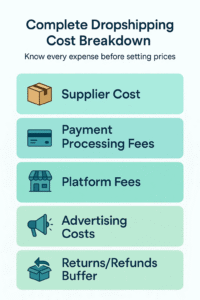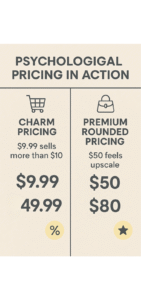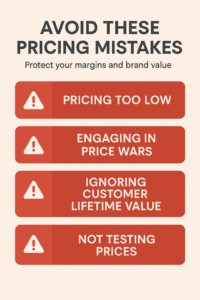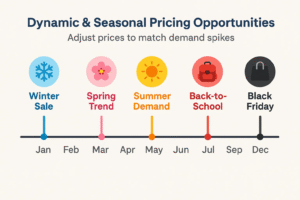Understanding how to establish dropshipping pricing strategies effectively can be the deciding factor between running a struggling business and operating a thriving online store. Recent industry data shows that dropshipping businesses using strategic pricing strategies achieve up to 35% higher dropshipping profit margins compared to those relying only on basic markup methods. The real challenge lies not only in finding the correct numbers but also in applying pricing psychology techniques that balance profitability with what customers are willing to pay.
Determining the right price for dropshipping products requires careful planning. You must cover all expenses, adapt to market fluctuations, and remain competitive while ensuring substantial profits. Many new sellers make the mistake of setting prices too low, believing it will drive more sales, or pricing too high in an attempt to achieve maximum profit per unit. Without proper competitor pricing analysis and an understanding of overall market dynamics, both approaches can harm long-term growth.
Ready to scale your e-commerce business with expert automation? Explore our comprehensive dropshipping services and discover how we can help you build a profitable, hands-free online store.
Understanding Your True Product Costs
It is essential to have a clear understanding of your costs before establishing dropshipping pricing strategies that will generate consistent profit. This goes far beyond the price you see listed by a supplier on AliExpress or other sourcing platforms. Many new dropshippers overlook the detailed dropshipping cost calculation process and fail to account for all the hidden components that make up the overall cost of their products.
Breaking Down the Complete Cost Structure

While the supplier cost is your starting point, it is far from the only factor to consider. You must also factor in payment processing fees, which typically range from 2.9% to 3.5% per transaction. These fees might seem small at first glance, but when managing numerous orders, they can significantly reduce your profit margin calculation.
Platform fees are another significant cost element. Whether you sell on Shopify, Amazon, eBay, or your own store, each platform takes a share. Shopify charges a monthly subscription plus transaction fees, while Amazon applies a percentage of each sale and additional fulfillment charges if you use FBA.
Advertising costs should also be closely monitored, as they have a direct effect on dropshipping profit margins. For example, if you spend $2 in Facebook ads to make a $20 sale, that advertising spend must be included in your break-even pricing dropshipping calculations. Many experienced sellers allocate between 15% and 25% of their revenue to marketing, making it a significant portion of the overall e-commerce pricing optimization process.
Returns and refunds are part of running a dropshipping business and contribute to hidden expenses. Even with a no-return policy, you will still face chargebacks, damaged goods, and customer service cases. Smart sellers build in a 3–5% buffer to account for these costs.
Calculating Your Minimum Profitable Price
Once all expenses are clearly outlined, you can calculate the minimum price required to break even. For example, suppose your supplier charges $10 for a product. In that case, you must also include payment processing fees ($0.30 plus 3% of selling price), platform fees, advertising costs (around 20% of selling price), and a returns buffer (about 3% of selling price).
If your total costs come to around 35% of your selling price in addition to the $10.30 base cost, your minimum profitable price would be at least $16. This type of profit margin calculation ensures you avoid selling at a loss, a mistake that happens far more often than most dropshippers realize.
Market Research and Competitor Analysis
Understanding your competitors is essential for implementing successful dropshipping pricing strategies. Merely browsing a few of their websites is not enough. Practical competitor pricing analysis involves tracking price fluctuations over time, identifying gaps in the market, and understanding which product features and services customers value most.
Analyzing Direct and Indirect Competitors
Direct competitors are those selling the same products to the same target audience, and they are relatively easy to identify. However, indirect competitors can often provide more valuable competitive market analysis insights. For example, if you sell phone cases, indirect competition could include electronics stores, big-box retailers, and even local shops offering similar accessories.
Using tools such as Ahrefs or SimilarWeb can help you estimate competitor traffic and revenue. This data allows you to see which sellers are genuinely successful, rather than assuming a professional-looking website equals profitability. In some cases, a minimal design paired with consistent high traffic indicates far better performance than a flashy but low-converting store.
Price tracking should be a consistent part of your market research and competitor monitoring strategy. Setting up Google Alerts for your main products and reviewing competitor pricing weekly can help you stay ahead. While many successful dropshippers rely on automated competitor price monitoring tools, manual research often uncovers pricing opportunities that automated systems overlook.
Identifying Market Positioning Opportunities
Finding a pricing sweet spot that competitors have missed can be one of the most profitable approaches. For example, if most competitors price a product between $15 and $20, you may find success at $25 or $30 if you offer faster shipping, better product presentation, or enhanced customer support.
Studying patterns in customer reviews on competitor platforms can reveal opportunities for value-based pricing and dropshipping. Common complaints about product quality, shipping delays, or poor customer service create an opening to position your store as a premium option. Customers are often willing to pay higher prices for reliability, peace of mind, and a positive buying experience.
Need help setting up automated competitor monitoring and market analysis? Contact us today for personalized guidance on building a data-driven pricing strategy for your dropshipping business.
Psychological Pricing Strategies That Work
The psychology of pricing plays a crucial role in the success of dropshipping pricing strategies. The way you present prices can influence customer perception, purchasing behavior, and ultimately your revenue, often more than the actual number itself. This is why pricing psychology in e-commerce is a powerful tool for increasing sales and dropshipping profit margins.
The Power of Charm Pricing
Ending prices with 9 or 99, known as “charm pricing,” has been proven to increase conversions. Research suggests that prices ending in 9 can boost sales by 30–60% compared to rounded numbers. This technique works exceptionally well in the $10 to $100 range, which covers the majority of dropshipping products.
However, charm pricing is not suitable for every brand or product type. For value-based pricing dropshipping in premium or luxury markets, clean, rounded numbers can be more effective. For example, a sleek, high-end product may sell better at $50 rather than $49.99 because the rounded number reinforces an upscale image.
The key is to test different pricing strategies with your target audience. What works for tech accessories may not work for fashion, and what converts well for impulse purchases may not be as effective for planned purchases.

Anchoring and Price Comparison Techniques
Anchoring is a psychological pricing technique where a higher initial price is displayed to make the actual selling price appear more attractive. This is why “compare at” pricing works so well. For instance, showing that a product was originally $79 but is now $39 creates a stronger perception of value.
Bundle pricing strategies also take advantage of anchoring. Instead of selling products individually, offering bundled packages can increase the perceived value. For example, while a $25 phone case might seem expensive, a $45 bundle that includes a phone case, screen protector, and wireless charger feels like an unbeatable deal.
Volume discounts are another effective tactic to raise average order value optimization without hurting profit margins. Offers such as “buy 2, get 10% off” or “buy 3, get 20% off” encourage larger purchases while maintaining healthy per-unit profitability.
Dynamic Pricing and Seasonal Adjustments
Static pricing can work in stable markets, but dropshipping pricing strategies perform best in dynamic marketplaces where supplier costs, consumer demand, and competition often shift. Successful dropshippers understand that dynamic pricing dropshipping is essential for staying competitive and maximizing profit margins.
Responding to Market Changes
It is common for suppliers to adjust their prices, mainly when products are sourced internationally. Factors such as raw material costs, currency fluctuations, and seasonal demand can directly impact supplier pricing. Smart sellers maintain relationships with multiple suppliers to ensure pricing flexibility and avoid overreliance on a single source.
Demand-based pricing is another key element of e-commerce pricing optimization. When demand spikes, whether due to seasonal interest or viral trends, prices can be raised without hurting sales. Conversely, prices may need to be lowered when demand slows to encourage more conversions.
Dropshippers working with suppliers that have limited stock can benefit from inventory-based pricing. When popular items are nearly sold out, prices can often be increased significantly while still maintaining a healthy sales volume.
Seasonal and Trend-Based Pricing
While holiday seasons naturally present opportunities for premium pricing, experienced sellers also capitalize on micro-trends and viral events. A product featured in a trending TikTok video, for example, might sell for 2–3 times its usual price for several weeks before demand returns to normal.
Different times of the year, such as the back-to-school season, summer vacations, and major shopping events like Black Friday, require tailored seasonal pricing strategies. Planning well in advance helps negotiate better supplier rates and maintain control over inventory.
Even weather-driven demand can create profitable opportunities. Sunglasses, umbrellas, and seasonal apparel often see sharp spikes in sales when timed with weather conditions, allowing for strategic price increases that boost dropshipping profit margins.
Testing and Optimizing Your Pricing Strategy
The most successful sellers in dropshipping pricing strategies understand that setting prices is not a one-time decision but an ongoing process of testing and refinement. Consistent experimentation can reveal slight changes that have a massive effect on profit margins over time.
A/B Testing Different Price Points
In systematic price testing, it is essential to change only one variable at a time while ensuring your sample size is large enough to be statistically reliable. Test different dynamic pricing dropshipping models for the same product, explore various discount structures, and try alternative product presentation methods to see which approach drives better conversion rates.
Using tools like Google Optimize or specialized e-commerce pricing optimization platforms can automate much of this work. However, manual testing through marketing campaigns can often provide deeper insights into customer behavior.
Keeping a detailed record of each test, along with its results, is critical. Even a slight improvement in conversion rate can translate into thousands of dollars in additional annual revenue for your dropshipping store.
Monitoring Key Performance Metrics
Conversion rate is just one piece of the puzzle. For example, a lower-priced product might achieve a 5% conversion rate, while a higher-priced version sells at 3%. The higher-priced option may still be more profitable due to increased margins and higher average order value.
Another important metric is customer lifetime value. If higher pricing attracts buyers who make repeat purchases, the initial conversion rate matters less than the long-term profitability those customers bring.
Average order value also plays a key role in bundled pricing strategies and upselling. In many cases, increasing the price of individual products while offering appealing bundle deals can raise total revenue while still improving customer satisfaction.
For those looking to implement advanced automation strategies, our Walmart dropshipping automation services can help you build hands-free stores that automatically adjust pricing based on market conditions and competitor analysis.
Advanced Pricing Techniques for Maximum Profit
Understanding the fundamentals of pricing opens the door to advanced dropshipping pricing strategies that can help you gain a strong competitive edge and significantly increase your profits.
Value-Based Pricing Models
A value-based pricing model focuses on the perceived worth of your product rather than just the production cost plus a markup. This method is especially effective in e-commerce pricing optimization because it connects directly to the problems your products solve for customers.
To apply this approach, you need an in-depth understanding of your audience and the pain points they face. Polls, customer reviews, and social media discussions are valuable tools for uncovering what matters most to buyers. Often, customers are willing to pay more if your product saves them time, reduces frustration, or eliminates costly problems.
For example, a phone case that protects against screen damage and prevents expensive repairs holds far greater perceived value than one that simply looks stylish. Using case studies and testimonials in your marketing helps reinforce that value and justifies premium pricing.
Geographic and Demographic Pricing
Identical products can command different prices depending on the target market. Urban shoppers may be more willing to pay higher prices than rural customers, and various age groups often have different levels of price sensitivity.
For dropshippers selling internationally, location-based pricing can be a powerful tactic. In regions with less competition or higher perceived value, a product that sells for $30 in the United States might be priced at $50 or more elsewhere.
Analytics can help you identify customer segments that are less sensitive to price changes. You can then target these audiences with premium versions of your products and custom marketing campaigns.
Subscription and Recurring Revenue Models
Adding subscription-based pricing to your dropshipping business model can transform a single sale into ongoing income. Subscription boxes, consumable goods, and seasonal products work exceptionally well. Some customers may hesitate to make a one-time $60 purchase but will readily agree to $15 monthly payments to reach the exact total.
Membership pricing also creates a sense of exclusivity. Premium members can receive early access to new products, special discounts, or exclusive pricing that non-members cannot access. This builds customer loyalty while reducing your overall marketing costs and providing steady, predictable revenue.
Standard Pricing Mistakes to Avoid
Gaining insights from common dropshipping pricing mistakes can help you avoid unnecessary trial and error while protecting your profit margins from costly setbacks.
Pricing That Drives Results
Competing solely on price often leads to a downward spiral that benefits only bargain hunters who make a single purchase and never return. Price-sensitive customers, especially those with no brand loyalty, are also the most likely to complain about quality when prices are low.
Instead of entering a price war, focus on service, value, and convenience. In the world of e-commerce pricing strategies, customers are often willing to pay higher prices when they receive faster shipping, outstanding customer service, or premium product presentation. These factors attract high-value buyers and help maintain healthier margins.
Lowering prices should not be your default move. Often, raising perceived value through better branding, clear product descriptions, and professional imagery can increase trust in your pricing. Many customers associate extremely low prices with poor quality, which can make conversions harder even when your products match or exceed competitors’ offerings.

Ignoring Customer Lifetime Value
Relying only on first-purchase metrics when setting your price limits your understanding of long-term profitability. For example, a customer who spends $40 on their first order and never returns is less valuable than one who spends $50 initially and then makes three more purchases over time.
Incorporating customer lifetime value in pricing decisions can transform your business. By identifying and targeting customers likely to make repeat purchases, you can justify premium pricing and reduce reliance on constant discounting.
Follow-up engagement through email marketing, loyalty programs, and retargeting ads is crucial. When your pricing strategy for dropshipping attracts customers with high lifetime value, the ROI from your marketing efforts increases significantly, making higher prices not only sustainable but also more profitable in the long run.
Ready to implement a comprehensive pricing strategy that maximizes your dropshipping profits? Get started with our expert automation services and let us help you build a profitable, scalable e-commerce business with optimized pricing from day one.
Conclusion
Mastering dropshipping pricing requires much more than simply adding a markup to supplier costs. It means understanding your real expenses, researching your market, and testing the limits of what your customers are willing to pay. The most successful dropshippers apply thorough cost analysis, psychological pricing strategies, and ongoing optimization to keep profit margins strong.
Begin by calculating every expense in detail, including transaction fees, advertising expenses, packaging, and even small operational charges that are easy to overlook. Study your competitors closely, but remember that winning in competitive dropshipping markets should not be based on price alone. Focus on value-driven offers that justify premium pricing, such as faster shipping, exceptional customer support, and unique product positioning.
Test different price points and track more than just conversion rates. Metrics like average order value and customer lifetime value can often be more critical for long-term success. Adjust your prices in response to seasonal demand, emerging market trends, or supplier changes, but avoid constant fluctuations that could confuse or frustrate customers.
Above all, remember that e-commerce pricing is an ongoing process, not a one-time decision. Markets shift, competitors evolve, and strategies that work today might fail tomorrow. Building a system that allows you to respond quickly to opportunities while maintaining healthy profit margins will give you the flexibility and resilience needed to grow a profitable dropshipping business.
Frequently Asked Questions
- What profit margin should I aim for in dropshipping?
Successful dropshippers typically target profit margins between 20% and 40% after all costs. However, margins vary significantly by product category, competition level, and market positioning. Electronics often have lower margins (15-25%), while fashion and home décor can support higher margins (30-50%). Focus on total profit dollars rather than percentages, as a 20% margin on a $100 product generates more profit than a 40% margin on a $25 product.
- How often should I adjust my dropshipping prices?
Price adjustments should be data-driven rather than calendar-based. Monitor competitor prices weekly and adjust when you see significant market movements. Seasonal adjustments typically happen monthly during peak seasons and quarterly during stable periods. However, avoid constant price changes that confuse customers or damage brand credibility. Significant price increases should be implemented gradually over 2-3 weeks to minimize customer shock.
- Should I use the same pricing strategy for all my products?
Different products require different pricing approaches based on competition, demand patterns, and customer behavior. High-competition products might need competitive pricing, while unique items can command premium prices. Test different strategies for different product categories and scale successful approaches. Luxury positioning works for some products, while value positioning works better for others, even within the same store.
- How do I handle supplier price increases without losing customers?
Communicate price increases transparently and provide advance notice when possible. Explain the reasons (improved quality, better service, market conditions) rather than simply raising prices without explanation. Consider absorbing small increases temporarily while implementing gradual price adjustments. Bundle pricing and value-added services can offset price increases while maintaining customer satisfaction.
- What tools can help me monitor competitor prices automatically?
Several tools offer automated competitor price monitoring, including Prisync, Price2Spy, and Competeera for comprehensive tracking. Google Alerts provides free basic monitoring for specific products or brands. Many successful dropshippers use simple spreadsheet systems combined with weekly manual checks for more accurate insights. The key is consistent monitoring rather than expensive tools, as market conditions change faster than automated systems can often detect.
Ready to implement a comprehensive pricing strategy that maximizes your dropshipping profits? Get started with our expert automation services, and let us help you build a profitable, scalable e-commerce business with optimized pricing from day one.



